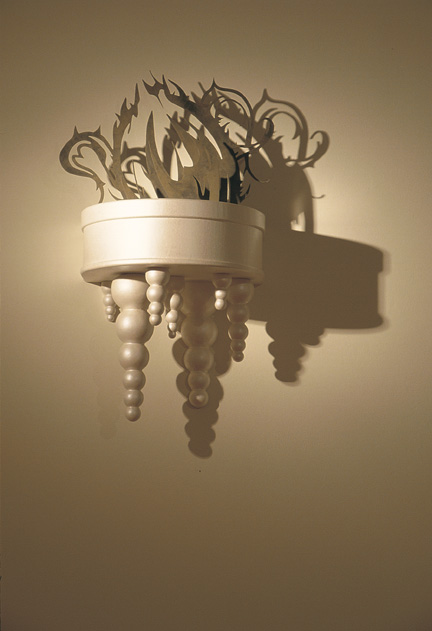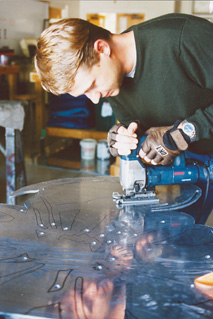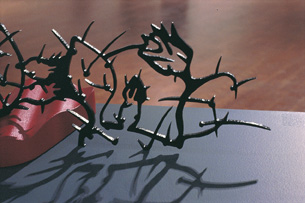

Education
Crawfordsville High School
Wabash College
Magna Cum Laude
major in visual arts, minors in biology, mathematics
Masters of Fine Arts
University of Nevada Las Vegas
Selected Exhibitions
“Recent Works by Jeff Fulmer,”
Wabash College Fine Arts Center
“Jeff Fulmer: New Works,”
Clark County Government Center, Las Vegas, Nevada
“48th Annual Jurored Exhibition,”
Las Vegas Art Museum (second-place award)
“11 Native Las Vegans: Drawings and Sculpture by Jeffrey Fulmer,”
Grant Hall Fine Art Gallery, UNLV
Commissioned Works
Las Vegas “Tree Guard” Project
Las Vegas Aerial Gallery
Stupak Community Center



See more of Jeff Fulmer's
work at:
www.wabash.edu/
depart/art/faculty/Fulmer/
Gallery(Jeff).html
Magazine
Fall/Winter 2001
Alumni Gallery
Jeff Fulmer ’97
“It was very minimalist, and some of the people in the area didn’t think it was sculpture,” he recalls. “I didn’t really understand why it was so controversial. I remember that conversation more than the sculpture itself. It was the first time I really gave thought to what an artist was trying to do and the reaction the audience can have to it.”
Those thoughts have been evolving and shaping artwork ever since—from the sculpture classes he took from Bob Sable in Crawfordsville in third grade to award winning exhibitions in Las Vegas to his present vocation as visiting professor and an unofficial artist in residence at Wabash.
Some excerpts from our conversation with the artist:
Who were your early influenes?
My mother took my brothers and me to museums and galleries. I went to the Indianapolis Museum of Art and places in Chicago. When we lived in South Bend, we'd hop on the South Shore and go to chicago.
Mom was a stay-at-home mom, but she always had an interest in art. She had a stained glass studio, and made stained glass windows. Later she got an MBA and we moved to Crawfordsville and she worked at Donnelly. She left Donnelly and got a teaching certification, and started teaching elementary school in gifted and talented program in Nevada.
So your mom liked your choice of vocations; how about your dad?
Dad’s been struggling with my being an artist, and trying to understand my point of view, and what art is about. He likes representational work and has slowly come around to what I’m doing. He really wanted me to go into business.
As a student here, I had many conversations about what I wanted to do, and it never included business.
Before I came to Wabash, I'd been accepted into the engineering program at Purdue, and I was also looking at IUI. But I came to Wabash thinking of majoring in art, unbennounced to my father. I said I’d double major in art and something practical, but I slowly moved to just wanting to focus on art.
What finally led you to become an art major?
I had Greg as my freshman tutorial professor and I talked with him a lot. Finally we had a conversation in his office, and I told him I needed to do something practical, and he spent some time talking to me about how you could make a career in art, and how important it is to find something you really want to do and enjoy, and that a career could come from that.
I told dad about that. He didn't buy it (laughs)! But he encouraged me to do"whatever you want to do—I just want you to be happy."
It’s a lot of hard work. I think my fellow grad students at UNLV, and the same was true of the seniors that I worked with here, we all kind of worked together and pushed each other. I was fortunate to have grad students who were really committed and interested in making a lot of good art, and we would have conversations about that, and we grew together as a group and pushed each other.
From what I've seen of your creative process and your teaching, you see the creation of art as something done for and in community—not the work of isolated, "crazed" geniuses as the vocation is sometimes depicted in movies.
I think art is a very social practice. If you look at most of the famous artists; most of the famous artists worked in small groups. Pollock's life has been pushed forward and made an example of because he lives the stereotypic life—his lifestyle became what people think of when they think of an artist. And there was a lot of drama in his life; so much you could make a movie from it, which, of course, they did.
But I don’t think that’s the norm; I don’t think it ever
has been. Look at Jasper Johns—he was in a group with Rauschenberg
and others. Look at the artists in New York-they not only visit each other’s
studios and talk about each other’s art work, but they also get together
to have coffee, they go out to the same clubs, they form a really tight
bond and support each other.
I really want to get students here thinking that way. We talk about
that. I’m trying that with the three of them; we’re getting
together at least once a week to go to an exhibit somewhere, or watch
a video. The Sunday after Homecoming we’re going to Chicago to the
SOFA (Sculptural Objects and Functional Art) exhibit. One reason for that
trip is so they can see some good artwork, but part of it is so they can
get together outside of class socially and then hopefully come back to
class and talk about each other’s work and not be as guarded.
Without having that support and those friends—if you isolate yourself—
noone will find out about your artwork. You won't have a stream of collector’s
coming by, you won’t find out about exhibits, no one will discover
you.
And with other artists, you can talk about who the audience is, who we
want our work to talk to.
Do you also learn from your audience?
The exchange with audience has influence, but not so much directly. Everyone
comes up to the artist when you’re having a show and says “great
work” and “I really like that”. You have to take that with
a grain of salt. They’re not likely to come up to you and say “Hey,
I don’t know about this stuff—what do you think you’re
doing,” unless they’re close friends. Even then, they’ll
wait till afterwards.
But I really like to watch how people react physically when they walk
into the room. You can tell a lot from someone’s posture and facial
expressions, and that’s more honest, I think, than someone coming
up to you and saying great work. I hope their eyes light up; that they’re
not hunched over, just being dragged to another art exhibit.
What's the first artwork you recall creating?
(Laughs) A ceramic house, complete with swimming pool, and a waterslide,
and lot of fun details. a swing set; the house ended up being very small,
and all the fun stuff radiated out and loomed over it.
When I was in grade school, I didn’t like coloring books as much
as having a fresh, clean, sheet of paper. I took some classes from Bob
Sable, who had taught art in elementary schools in Crawfordsville. He
offered summer classes, and I took those starting in third grade. He had
drawing and sculpture, and I always gravitated to the 3-D.
Talk a little about these tools hanging from your studio walls.
These are my grandfather’s tools. He enjoyed woodworking; it was
a hobby for him. He worked for Indiana Gas, primarily as a pipefitter.
But after work he would build amazing things. He built my mother when
she was a little girl, and that dollhouse that was too big to get out
of the basement, too big to get through the door. He had dreams of building
a sailboat.
After my grandfather died, I would go to his house every summer to sort
of help clean things up. I was cleaning out the garage when I saw these
tools of his, and I asked if I could have them.
I use some of the tools in my work, but they're not hanging on my wall—they’re
in my toolbox.
The older tools are collector’s items, beyond the sentimental value
they hold for me, and they're interesting conversation pieces
You're known at Wabash as sculptor, but you also paint.
I like the physical process of sculpting, but Ithink the painting
and sculpting inform each other. My most recent paintings, to some extent,
are the result of how physical the sculpting process is. Up until two
days before I moved back to school here, I was working on outdoor sculpture
commissions for the city of Las Vegas, and the work was very physical.
I was rushed to get them done. I was physiclaly sore for a while afterwards,
and I decided that this summer I would do something that was a little
less physical. give my body a little bit of a break.
These paintings are kind of floating, they’re not grounded, and I
intentionally used metallic and iridescent paints so they’d be a
little more sculptural. the metallic picks up light in different ways
depending on how you stand, so the painting changes as you move, more
like scultpure.
I don’t want to be labeled a painter or sculptor, but if I have to
choose one, I’d choose sculptor.
Which vocation did you aspire to first: teacher or artist?
At Career Day at Tuttle Middle School, I stayed with Mr. Speare, the art
teacher. That was my first choice of careers to consider.
When I went on to high school, Ithought it would be cool to teach high
school art.
Then when I came to Wabash, I thought it would be really cool to be a
college art professor. I held on to that in grad school, butI also met
more people who were making it as just artists, and that side fascinates
me, too. I enjoy both, but the desire to teach came first.
Actually, the two vocations fit together well. Students are an excellent
resource for an artist. They’re very creative, they don’t necessarily
have the same expectations as others, and their concept of art isn’t
as solid and set as mine, so they challenge me as much or more than I
challenge them. They say what they’re really thinking, not just what
someone told them to say.
Return to the table of contents
